The Olive tree, scientifically called Olea europaea, belongs to the family Oleaceae. It is a captivating subtropical broad-leaved evergreen tree cherished for centuries due to its beautiful appearance and delectable fruit. Whether you have limited garden space, live in a colder climate, or want the flexibility to move your Olive tree around, planting one in a pot is the perfect solution.
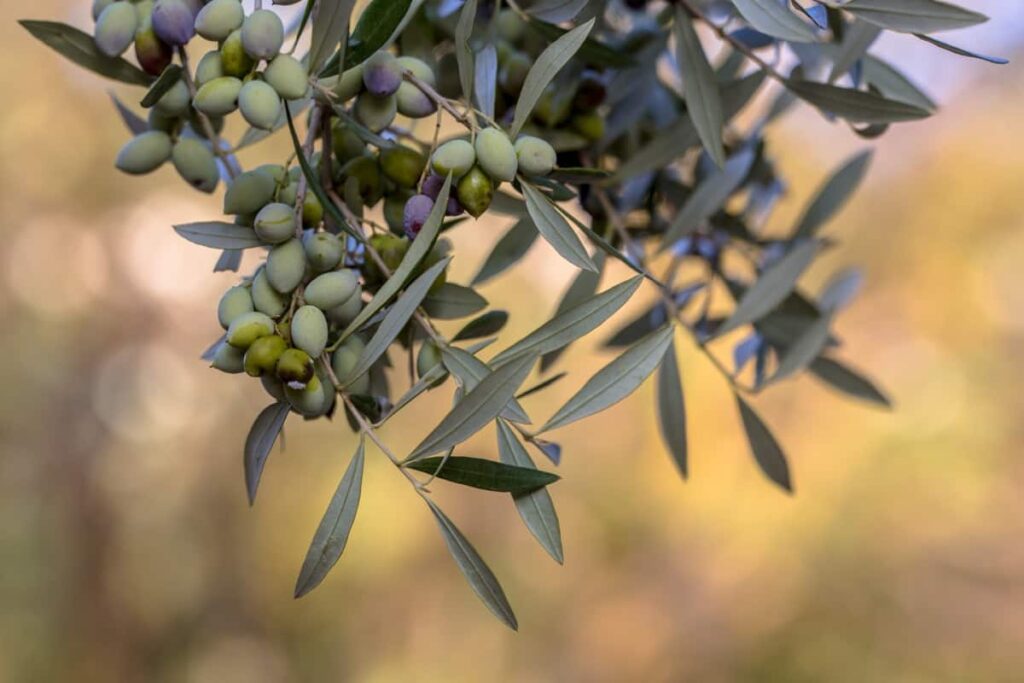
How to Grow Olive Trees in Pots
Choosing the Right Pot Size and Material for Olive Trees
Terracotta or wood is preferable when growing Olive trees in pots or containers. Terracotta pots are porous, allowing for better drainage and airflow to the roots. This helps prevent overwatering and root rot, which can harm Olive trees. Wood provides insulation, regulating soil temperature and preventing excessive heat or cold from affecting the roots. Additionally, wood allows for natural moisture retention without causing waterlogged conditions.
It is important to select a container that will accommodate the tree’s root system as it grows. A larger pot allows room for expansion and prevents overcrowding of roots. Consider the size of your Olive tree when choosing a pot. For young saplings or smaller varieties, a 10–12-inch diameter pot should suffice initially. As they grow, you may need to increase the container’s size gradually.
Remember that proper drainage holes are essential regardless of the pot material or size chosen. These ensure excess water can escape easily instead of accumulating at the bottom. Selecting an appropriate pot size and material provides optimal conditions for your potted Olive tree’s growth and overall well-being.
Selecting the Right Soil Mix for Olive Trees in Pots
Selecting the right soil mix for Olive trees is crucial for their health and growth. Your soil should provide proper drainage while retaining enough moisture for the roots to thrive. A good starting point is using a high-quality potting mix formulated for container gardening. These mixes are usually lightweight and well-draining, which helps prevent soggy roots. Adding perlite to the potting mix further improves drainage. This will make air pockets in the soil and allow excess water to drain away more efficiently.
Olive trees also prefer slightly alkaline soil with a pH between 7 and 8. Adjust the soil pH by adding dolomite lime if needed. Another important consideration is incorporating organic matter into the soil mix. This could include compost or well-rotted manure, providing essential nutrients to nourish your Olive tree. Remember that it’s always best to choose a larger pot so there’s ample space for root development and better access to nutrients in the soil.
In case you missed it: 15 Best Tomato Cages with Price for Pots, Large Plants, and Indeterminate Tomato Vines
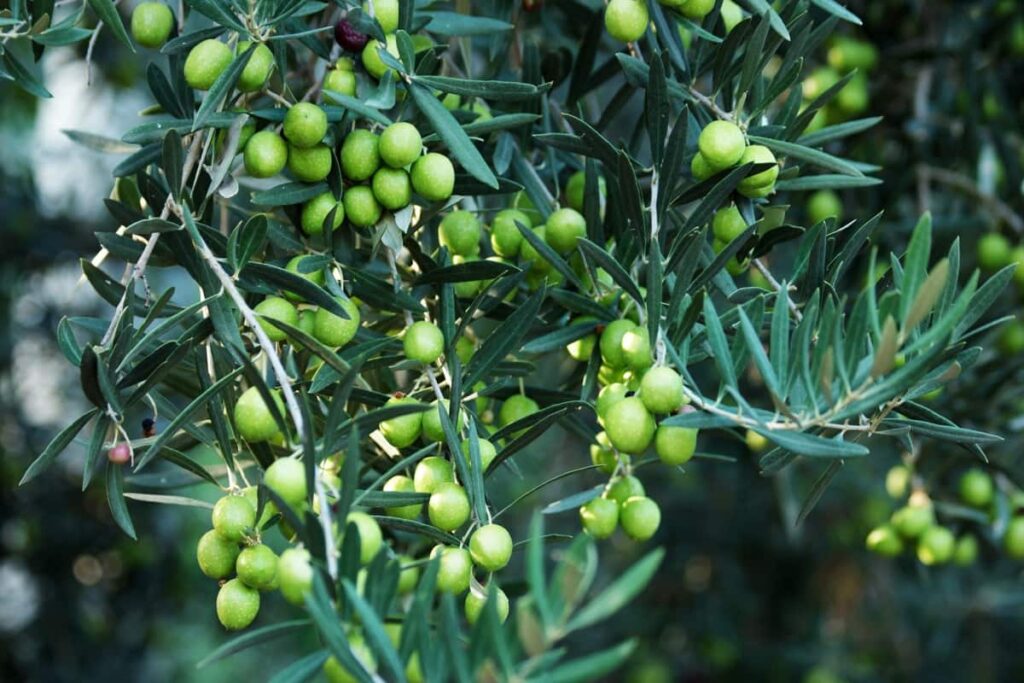
Providing Adequate Lighting for Growing Olive Trees
Olive trees thrive in full sun conditions. Therefore, placing your potted Olive tree in a spot that receives at least six hours of direct sunlight daily is important. Supplemental lighting can be beneficial for growing your Olive tree indoors or on a patio with limited sunlight. LED grow lights are the best option as they provide the right spectrum of light needed for photosynthesis. Position the grow lights about 12-18 inches above the plant and keep them on for 6 to 8 hours daily.
In addition to proper placement and supplemental lighting, rotate your Olive tree regularly. This ensures that all parts of the plant receive equal exposure to light, preventing uneven growth or leggy branches. Remember that while Olive trees love sunshine, excessive heat can be detrimental. If temperatures soar during summer, consider moving your potted Olive tree to a shaded area to protect it from the intense midday sun. Providing adequate lighting for your potted Olive tree will help promote healthy foliage growth and encourage fruit production in due time.
Propagating Olive Trees for Pot Growing
Propagating Olive trees is a rewarding experience, especially when you plan to grow them in pots. While Olive trees can be propagated from seeds, cuttings are recommended for better success rates. To propagate Olive trees from cuttings, start by selecting healthy branches about one year old with a diameter of around 1/4 inch. Use sterile pruning shears to make clean cuts at a 45-degree angle below a node. Remove the lower plant leaves from the cutting to expose the nodes where roots will develop.
Prepare a well-draining potting mix using equal parts perlite and peat moss or coconut coir. Moisten the mixture before filling small pots with it. Insert each plant cutting into a pot filled with moistened potting mix until only two nodes are visible above the soil surface. Place the pots in a warm area with indirect sunlight. Mist regularly to maintain humidity levels around the cuttings.
After several weeks, check for root development by gently tugging on each cutting. If there is resistance, roots have formed successfully. Once rooted, transplant each cutting into a larger container filled with a well-draining soil mix suitable for potted Olives. Remember that propagating Olive trees may take time and patience as they require specific conditions to thrive in pots.
Planting the Olive Tree in the Pot
Firstly, choose a large pot for the roots to spread comfortably. A terracotta or wood container is preferable as it allows for better drainage. Next, select the right soil mix for your Olive tree. A well-draining mixture of sandy loam and compost will provide the ideal conditions for growth. Make sure to fill the pot about two-thirds full with this soil mix. Now it’s time to plant your Olive tree in pots. Remove the tree from its nursery container and loosen any tightly bound roots.
In case you missed it: Best Fertilizer for Curry Leaves in Pots: Organic, Natural, Homemade, NPK, When and How to Apply
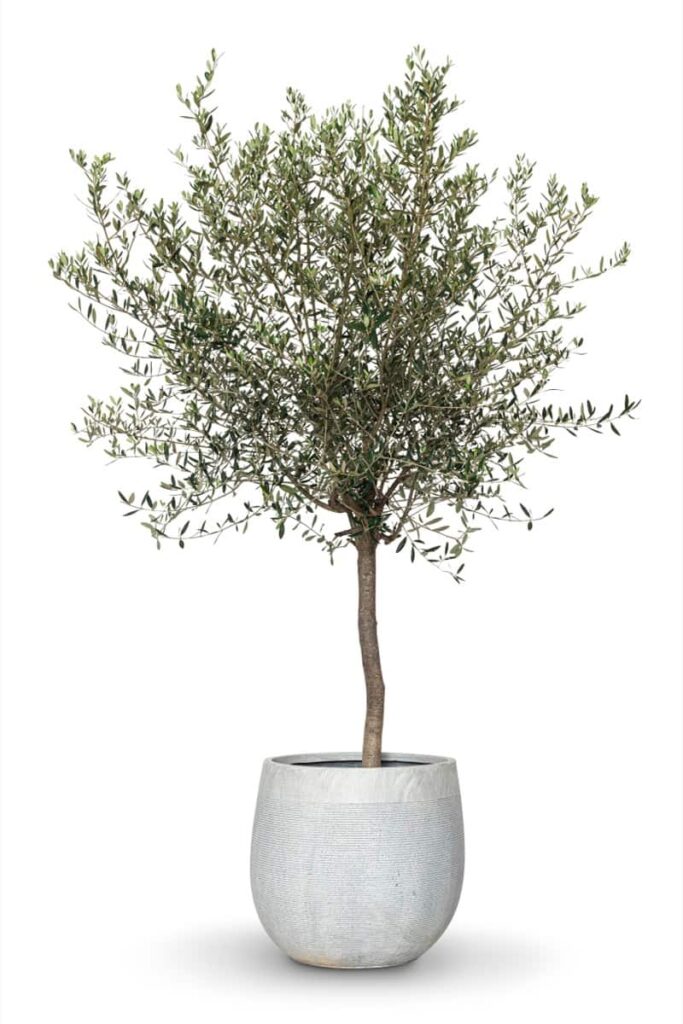
Please place it in the center of your prepared pot, ensuring it is positioned at the same depth as in its original container. Backfill around the roots with more soil, firming gently as you go. Water the Olive plant thoroughly after planting to settle the soil and eliminate air pockets. Place your potted Olive tree in a sunny location where it can receive at least six hours of direct sunlight daily. This will ensure proper growth and fruit production.
Watering Olive Trees in Pots
Watering is important in caring for Olive trees in pots. The key here is to strike the right balance – not too much water, but not too little. Overwatering the Olive plant can lead to root rot and other issues, while underwatering can cause the tree to wilt and suffer. To ensure proper watering, it’s important to understand the needs of your Olive tree. It’s time to water during warmer months. When watering the Olive tree, thoroughly soak the soil until water comes from the pot drainage holes.
Allow excess water to drain completely before placing the pot back in its tray or saucer. Avoid letting your Olive tree sit in standing water, which can suffocate roots and promote disease. It’s also important not to let your potted Olive tree dry out completely between watering sessions. Remember that environmental factors such as temperature and humidity affect how often you water your Olive tree. Keep an eye on weather conditions and adjust accordingly.
Fertilizing and Pruning Olive Trees in Pots
How do you fertilize a potted Olive tree? When it comes to fertilizing, it’s important to provide the tree with the nutrients it needs for healthy growth. Use a balanced fertilizer specifically designed for fruit-bearing trees, following the instructions on the packaging. Plant pruning is necessary to maintain the shape and size of your Olive tree. Regular pruning helps stimulate new growth and prevents overcrowding within the pot. Start by removing any damaged branches and any suckers that may be growing from the tree’s base.
To promote better air circulation, selectively thin out crowded areas within the canopy. This will also help prevent disease development. Additionally, you can prune back long branches to encourage branching and denser foliage. It’s important to note that both fertilizing and pruning should be done during specific times of year when your Olive tree is actively growing or dormant. Consult a gardening guide or seek advice from local experts to ensure you’re timing these tasks correctly.
Temperature and Humidity Requirements for Olive Trees in Pots
Olive trees thrive in warm climates with mild winters, making them ideal for Mediterranean regions. Olive trees prefer temperatures between 21°C-29°C during the day and slightly cooler temperatures at night. During winter, Olive trees can tolerate temperatures as low as 6°C, but it is advisable to protect them from frost by bringing them indoors or providing adequate insulation. Olive trees prefer moderate levels ranging from 50% to 60%. However, they can tolerate higher or lower levels within reason.
In case you missed it: Unlocking the Secrets of Optimal Fertilizer Requirements for Potato Crop
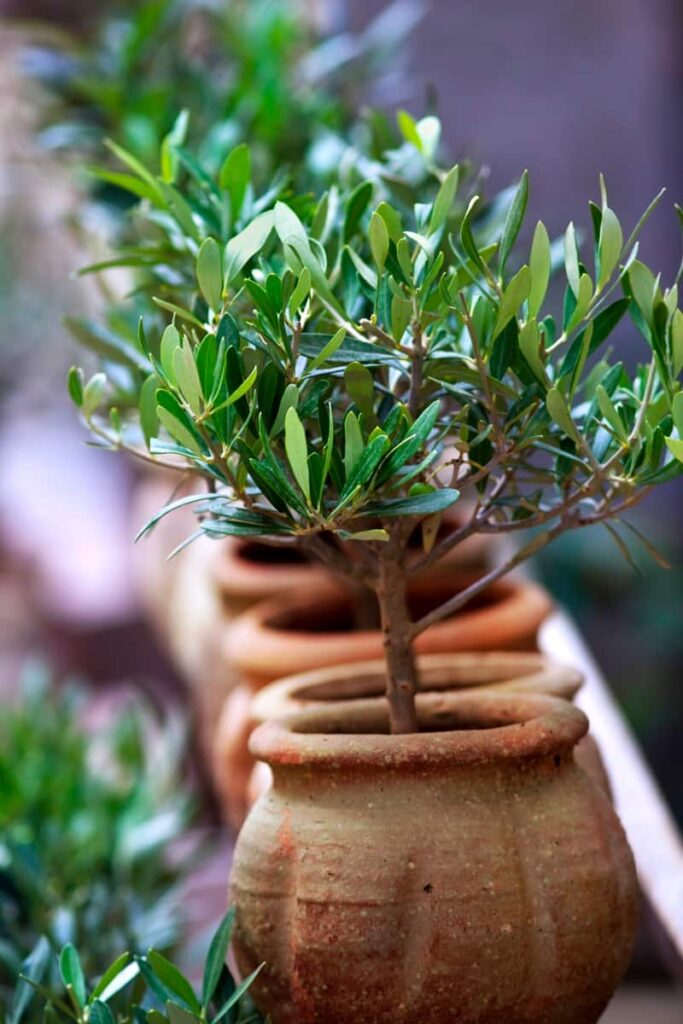
If you live in a highly humid region, ensure proper air circulation around your potted Olive tree to prevent fungal diseases like root rot. On the other hand, if you reside in an arid climate with low humidity levels, consider misting the leaves occasionally or placing a tray filled with water near the pot to increase moisture around the plant. Remember that maintaining suitable temperature and humidity conditions will contribute significantly to the overall well-being of your potted Olive tree.
Repotting and Transplanting Olive Tree
When repotting your Olive tree, it’s important to select a pot or container that is larger than its current container. This will give the roots room to spread out without becoming cramped. Additionally, ensure the new pot has drainage holes at the bottom to prevent waterlogged soil. Before transferring your Olive tree, gently remove it from its current pot by tapping on the sides and carefully loosening any tangled roots.
Be gentle with the root system, as damage can hinder its growth potential. Next, prepare a well-draining soil mix of equal parts sand, peat moss, and perlite or vermiculite. Place some of this mixture at the bottom of the new pot before adding your Olive tree. Position your Olive tree in the center of the new pot and fill in around it with more soil mixture until secure.
After repotting, water thoroughly until water drains from the bottom holes. This helps settle down any remaining air pockets within the soil while providing hydration for proper root development. Remember that repotting should typically be done every two years during spring when plants are actively growing. Transplanting should be reserved for situations where your Olive tree has become too large for indoor cultivation alone or if you plan on moving it outdoors permanently.
Caring for Young Olive Trees in Pots
These small trees require special attention and care during their early stages. Providing the right amount of water to young Olive trees is important. Keep the soil moist but not too wet, as excessive watering of the Olive plant can lead to root rot; check the moisture level by inserting your finger into the soil. Proper fertilization is key for young Olive trees in pots. Use a balanced fertilizer specifically formulated for fruit-bearing plants.
Apply it according to package instructions, taking care not to over-fertilize the Olive plant as this can harm the tree. Additionally, pruning is crucial in shaping young Olive trees and promoting their overall health. Remove any dead or damaged branches and suckers that may emerge from the tree’s base. Place your potted Olive tree in a sunny location where it receives at least six hours of direct sunlight daily.
In case you missed it: 12 Garden Watering System Kits – For Raised Garden Beds, Yards, Container Plants, Lawns, and Greenhouse
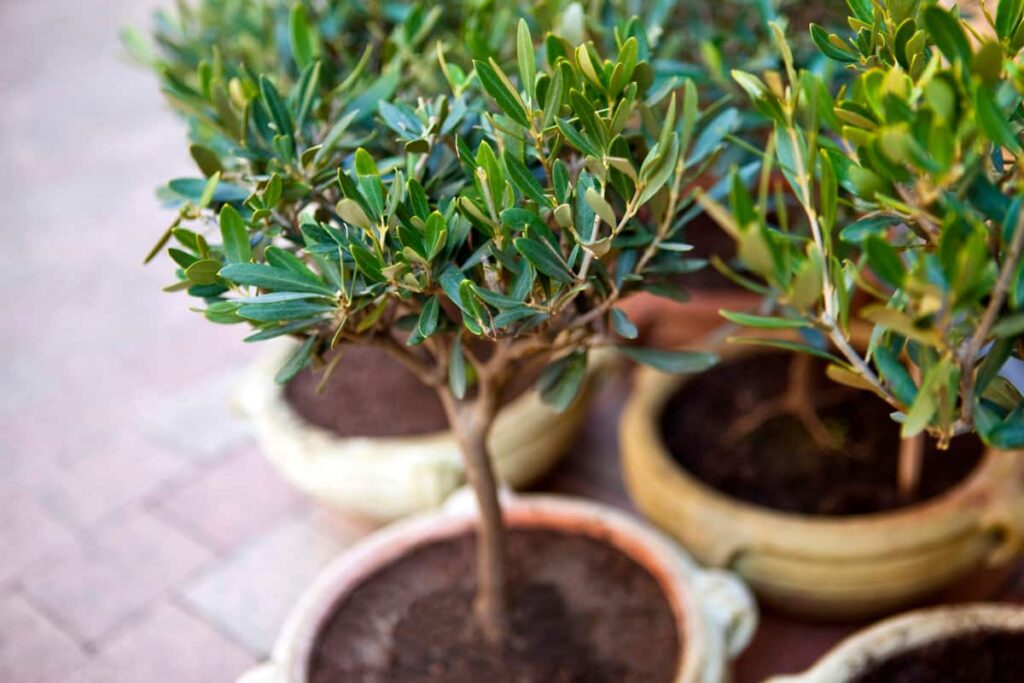
Protecting Olive Trees from Pests and Diseases
These can harm the health and productivity of your Olive trees, so it’s important to take proactive measures to protect them. There are many problems with Olive trees in pots, and watch for common pests such as aphids, scale insects, and Olive fruit flies. Regularly inspect your Olive trees for any signs of infestation, including distorted leaves or damaged fruits. If you spot any pests, consider using organic solutions to control their population.
In addition to pests, Olive trees are susceptible to diseases like verticillium wilt and peacock spot. To prevent these illnesses from spreading in your potted Olive tree, ensure proper air circulation around the plant by placing it in an open area. Maintaining good hygiene practices is crucial as well. Clean up fallen leaves or debris around the pot regularly since they can harbor disease-causing pathogens. Furthermore, consider applying preventative treatments such as copper-based fungicides when conditions favor disease development.
Harvesting Olives from Pots
Keep an eye on your Olive tree as it matures, and pay attention to the color change of the fruit. How do I know when Olives are ready to pick? Olives should be harvested when they have reached their full size but before they fully ripen. This is usually when they turn from green to a purplish-black hue. Unlike other fruits, ripe Olives are delicate and easily bruised or damaged during harvest. To avoid this, use gentle techniques such as handpicking or carefully using a small pruner or scissors to remove individual Olives from the branches.
Freshly harvested Olives contain bitter compounds that need to be removed through curing before they become palatable. One traditional method is brine-curing, where fresh Olives are soaked in salt water for several weeks until bitterness dissipates. Once cured properly, your homegrown Olives will be ready for consumption. You can incorporate them into dishes like salads and pasta sauces or enjoy them as a delicious snack.
In case you missed it: 14 Fruits Trees that Provide High-Quality Wood and Lumber
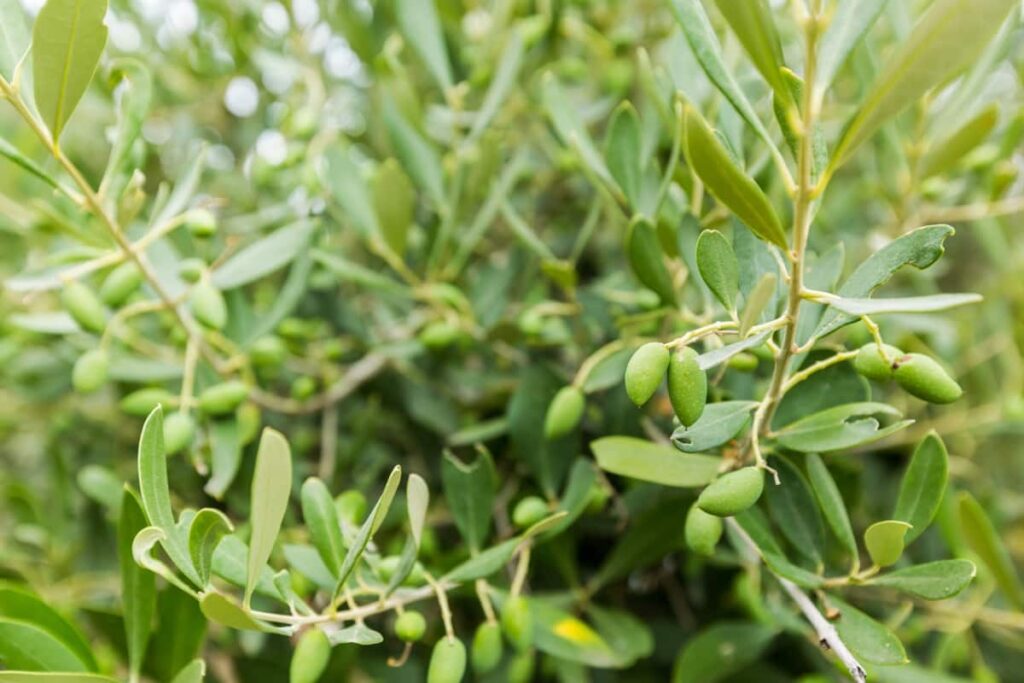
Conclusion
Growing Olive trees in pots allows individuals with limited space or different climates to experience firsthand the joy of growing these remarkable trees. Choosing the right pot for growing Olive trees is essential. Terracotta or wood pots are preferable as they allow for proper drainage around the roots.
- Profitable Village Farming Business Ideas in 2024
- High-Yield Aquaculture: Fast-Growing Fish for Farming
- Effective Fish Pond Construction Techniques for Beginners
- Irrigation and Water Management in Pineapple Farming
- Blossom to Harvest: Mastering Flowering and Pollination in Papaya Farming
- Pig Fattening Essentials: From Selection to Sale for Beginners
- Raising Wagyu Cattle: A Complete Guide for Premium Beef Production
- Soil Types and Their Water Holding Capacity
- Optimizing Irrigation Schedules for Coconut Groves for Enhanced Yield
- Espresso Your Garden: Coffee Grounds for Healthier Acid-Loving Plants
- The Best Soil Mix for Snake Plants: How to Mix Your Own Snake Plant Soil
- Green Thumb Success: Expert Tips for Cultivating Greenhouse Beans All Year Round
- Bloom All Year Round: The Ultimate Guide to Indoor Hyacinth Care
- Eco-Friendly Gardening: How to Make Liquid Fertilizer from Kitchen Waste
- Ultimate Guide to Grow Anise in Pots: Explore Seed Propagation to Harvesting
- Guide to Raising Chester White Pigs: Discover Breed Facts to Growth Management
- Mastering the Elegance: The Ultimate Guide to Weeping Cherry Tree Care, Planting, and Maintenance
- Ultimate Guide to Planting Garlic in Grow Bags: Growing Strategies for Beginners
- How to Fix Spider Plant Leaf-Related Problems: Natural and Organic Remedies
- 10 Reasons Why Your Tulsi Plant is Shedding Leaves: Home Remedies and Solutions
- Optimizing Growth and Yield: The Advantages of Palm Bunch Ash Fertilizer
- Utilizing Neem Oil Extract as a Natural Pesticide for Hydrangea
- From Soil to Harvest: Various Ways in Which Farmers Can Use AI Tools
- Steps to Encourage and Induce Citrus Flowers: A Comprehensive Guide
- How to Fix Snake Plant Leaf-Related Issues: Natural and Organic Remedies
- Transform Your Garden into a Fragrant Oasis with Raat Ki Rani (Night Blooming Jasmine)
- Discover the Ideal Chicken Breeds for Philippine Farms
- How to Create a Poultry Egg Farm Business Plan for Profits
- Grow Lemon Cucumbers Like a Pro: Insider Techniques for Bountiful Yields
- Ultimate Guide to Caring for Your Pink Princess Philodendron: Tips for Thriving Variegation
- Areca Nut Profit Per Acre: Calculating Yield and Cost of Cultivation
- How Kaveri Chicken is Becoming a More Profitable Breed in Indian Backyards
- Transform Your Barn: 9 Steps to Convert a Horse Stall into a Chicken Coop
- Exploring Suffolk Sheep Disadvantages with Limitations and Challenges
- Guide to Solving Potted Lemon Tree Problems: How to Revive Lemon Tree in Containers
- Steps to Encourage Female Pumpkin Flowers: Best Strategies for More Flowers and High Yields
